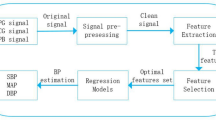Abstract
The context of this work concerns the development of a connected smartwatch for the continuous daily monitoring of physiological parameters to prevent cardiovascular diseases, and for the follow-up of the efficiency of treatments, against hypertension for example. This paper focuses on a particular parameter, the blood pressure (BP), to be automatically measured from the Photoplethysmogram (PPG) signal, to be acquired using a smartwatch. The proposed method is based on the automatic pulse wave detection from the PPG signal. Then, using the Lasso algorithm, a relation has been established between the blood pressure and the spectral representation of the normalized pulse wave, combined with other physiological information (age, body mass index and hear rate). The proposed method has been evaluated on a recent large public database of 219 subjects, covering a large range of ages (20–89), body mass indices and of blood pressures. Experimental results show acceptable performances in terms of accuracy. Compared to a recent related work depicting a slightly lower estimation error, a strength of our approach regards its robustness with respect to the signal quality, this being crucial for a use in daily routine in real IoT conditions, as it is the case in this context of smartwatch.
Access this chapter
Tax calculation will be finalised at checkout
Purchases are for personal use only
Similar content being viewed by others
References
Murray, W.B., Foster, P.A.: The peripheral pulse wave: information overlooked. J. Clin. Monit. 12(5), 365–377 (1996)
Perloff, D., Sokolow, M., Cowan, R.: The prognostic value of ambulatory blood pressures. JAMA 249(20), 2792–2798 (1983)
Perloff, D., Sokolow, M., Cowan, R.: The prognostic value of ambulatory blood pressure monitoring in treated hypertensive patients. J. Hypertens. Suppl.: Official J. Int. Soc. Hypertens. 9(1), S33-9 (1991)
Yang, S., Zhang, Y., Cho, S.Y., Morgan, S.P., Correia, R., Wen, L.: Cuff-less blood pressure measurement using fingertip photoplethysmogram signals and physiological characteristics. In: Optics in Health Care and Biomedical Optics VIII, vol. 10820, p. 1082036. International Society for Optics and Photonics, October 2018
Liang, Y., Elgendi, M., Chen, Z., Ward, R.: An optimal filter for short photoplethysmogram signals. Sci. Data 5, 180076 (2018)
Liang, Y., Chen, Z., Liu, G., Elgendi, M.: A new, short-recorded photoplethysmogram dataset for blood pressure monitoring in China. Sci. Data 5, 180020 (2018)
Efron, B., Hastie, T., Johnstone, I., Tibshirani, R.: Least angle regression. Ann. Stat. 32(2), 407–499 (2004)
Goldberger, A.L., et al.: PhysioBank, PhysioToolkit, and PhysioNet: components of a new research resource for complex physiologic signals. Circulation 101(23), e215–e220 (2000)
O’Brien, E., Waeber, B., Parati, G., Staessen, J., Myers, M.G.: Blood pressure measuring devices: recommendations of the European Society of Hypertension. BMJ 322(7285), 531–536 (2001)
Author information
Authors and Affiliations
Corresponding author
Editor information
Editors and Affiliations
Rights and permissions
Copyright information
© 2020 ICST Institute for Computer Sciences, Social Informatics and Telecommunications Engineering
About this paper
Cite this paper
Mouney, F., Tiplica, T., Hallab, M., Dinomais, M., Fasquel, JB. (2020). Towards a Smartwatch for Cuff-Less Blood Pressure Measurement Using PPG Signal and Physiological Features. In: Garcia, N., Pires, I., Goleva, R. (eds) IoT Technologies for HealthCare. HealthyIoT 2019. Lecture Notes of the Institute for Computer Sciences, Social Informatics and Telecommunications Engineering, vol 314. Springer, Cham. https://doi.org/10.1007/978-3-030-42029-1_5
Download citation
DOI: https://doi.org/10.1007/978-3-030-42029-1_5
Published:
Publisher Name: Springer, Cham
Print ISBN: 978-3-030-42028-4
Online ISBN: 978-3-030-42029-1
eBook Packages: Computer ScienceComputer Science (R0)




